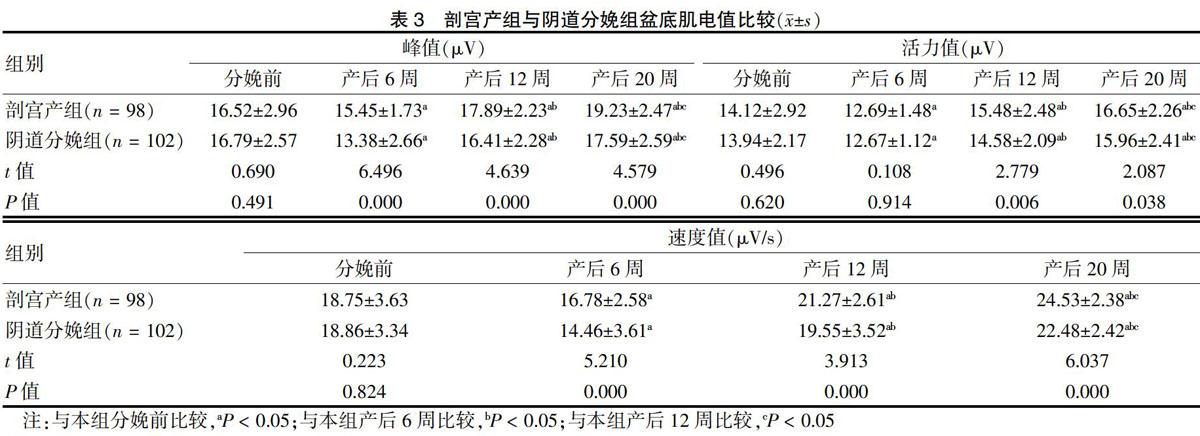不同分娩方式对产后早期盆底肌电值及肌力的影响
2019-10-09聂伟刘学云张琳琳黑国真
聂伟 刘学云 张琳琳 黑国真



[摘要] 目的 探讨不同分娩方式对产后早期盆底肌电值及肌力的影响。 方法 选取2015年6月~2018年10月于山东省聊城市东昌府区妇幼保健院产检并分娩的200例产妇为研究对象,按照分娩方式的不同将其分为剖宫产组(n = 98)和阴道分娩组(n = 102),阴道分娩组根据有无侧切分为侧切组(n = 53)和无侧切组(n = 49)。分别于分娩前、产后6周、产后12周、产后20周,比较剖宫产组与阴道分娩组、侧切组和无侧切组组间的盆底肌电值和肌力下降情况。 结果 产后6、12、20周,两组盆底肌电位峰值、活力值、速度值均呈先降低后升高趋势(P < 0.05);产后6周,剖宫产组除盆底肌电位活力值与阴道分娩组比较差异无统计学意义(P > 0.05)外,其余各时间点的盆底肌电位峰值、活力值、速度值均高于阴道分娩组(P < 0.05)。分娩前及产后6、12、20周,侧切组与无侧切组盆底肌电位峰值、活力值、速度值等比较,差异无统计学意义(P > 0.05),产后6周两组电位峰值、活力值、速度值均低于分娩前(P < 0.05)。分娩前及产后6、12、20周,剖宫产组、阴道分娩组以及側切组、无侧切组Ⅰ类肌、Ⅱ类肌肌力下降患者占比比较,差异均无统计学意义(P > 0.05)。 结论 剖宫产、阴道分娩对盆底肌力下降的影响区别不大,且阴道分娩中侧切不能减轻对产后盆底肌力的影响。剖宫产对产后早期盆底肌电值的影响较阴道分娩小。
[关键词] 剖宫产术;自然分娩;会阴切开术;产后;盆肌电值;肌力
[中图分类号] R714.254 [文献标识码] A [文章编号] 1673-7210(2019)07(b)-0095-05
Effect of different delivery modes on pelvic floor electromyography and muscle strength in early postpartum period
NIE Wei1 LIU Xueyun2 ZHANG Linlin3 HEI Guozhen3
1.Research Department, Shandong Academy of Medical Sciences, Shandong Province, Ji′nan 250000, China; 2.Department of Obstetrics, Shandong Provincial Qianfoshan Hospital, Shandong Province, Ji′nan 250000, China; 3.Department of Obstetrics, Liaocheng Dongchangfu District Maternal and Child Health Hospital, Shandong Province, Liaocheng 252000, China
[Abstract] Objective To investigate the effect of different delivery methods on pelvic floor electromyography and muscle strength in early postpartum period. Methods Total of 200 parturients who were examined and delivered in Liaocheng Dongchangfu District Maternal and Child Health Hospital of Shandong Province from June 2015 to October 2018 were selected as the research objects. They were divided into cesarean section group (n = 98) and vaginal delivery group (n = 102), vaginal delivery group was divided into lateral section group (n = 53) and non-lateral section group (n = 49) according to the different modes of delivery. The pelvic floor myoelectricity and muscle strength were compared between cesarean section group and vaginal delivery group, lateral incision group and the non-lateral incision group before delivery, 6, 12 and 20 weeks postpartum. Results The peak value, activity value and velocity value of pelvic floor potential in cesarean section group and vaginal delivery group decreased first and then increased at 6,12 and 20 weeks postpartum (P < 0.05). There was no significant difference in pelvic floor potential activity between cesarean section group and vaginal delivery group at 6 weeks postpartum (P > 0.05). The peak value of pelvic floor muscle potential, pelvic floor muscle activity and pelvic floor velocity at other time points were higher than those in vaginal delivery group (P < 0.05). There was no statistical difference in peak pelvic floor potential, pelvic floor activity and pelvic floor velocity between the two groups (P > 0.05), and the peak pelvic floor potential, pelvic floor activity and pelvic floor velocity of the two groups was lower 6 weeks postpartum than those before delivery (P < 0.05). There was no statistical difference in the decrease rate of muscular strength of type Ⅰ and Ⅱ muscles between cesarean section group, vaginal delivery group and lateral section group and non-lateral section group (P > 0.05). Conclusion The influence of cesarean section and vaginal delivery on the decrease of pelvic floor muscle strength is not different, and lateral incision during vaginal delivery can not reduce the influence of pelvic floor muscle strength after delivery. The effect of cesarean section on pelvic floor EMG in early postpartum period is slight.
